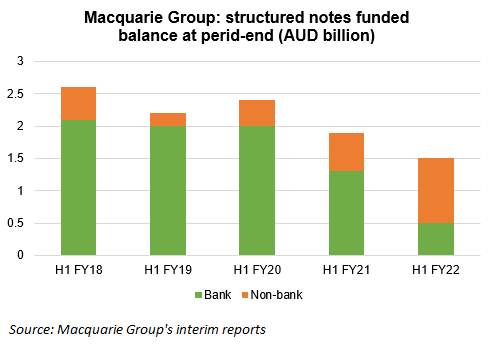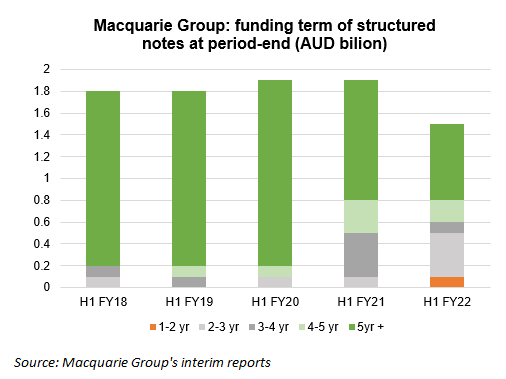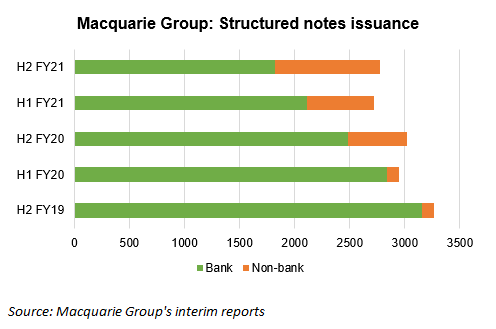The Australian bank’s issuance and sales posted a 20% decline year-on-year as the downward trend started five years ago continues.
The balance of structured notes at the Australian financial group has continuously dropped over the past five years, reaching AU$1.5 billion (US$1.1 billion) at the end of September, down 21.1% year-on-year (YoY).
The overall funded balance of structured notes saw a 42.3% decline compared with five years ago, according to Macquarie Group’s financial report of H1 FY22.
Approximately AU$1 billion of the funding came from Macquarie Bank, the main issuing entity of structured notes, while the remaining from Macquarie’s non-bank group.
The fall in activity resulted from the shift towards short-dated noted as the funding with a term of longer than five years decreased 36.4% to AU$700m as at 30 September YoY, or 56.3% lower compared to five years ago.
On a yearly basis, the funded balance of structured notes with a term of three to five years also slowed down while the balance of products with two to three year terms rose to AU$400m from AU$100m. There was an additional AU$100m of funding with one- to two-year maturities.
In terms of newly-issued structured notes, the volume was stable at AU$2.78 billion in the first half of FY22 YoY, 65.5% of which came from Macquarie Bank while the remaining was from non-bank subsidiaries comprising Macquarie Capital and Macquarie Asset Management.
Under its US$5 billion Structured Note Program, the banking arm posted US$400m of outstanding funding from structured notes as of 30 September, which more than halved YoY. The outstanding volume was US$700m at the non-bank group, up 75% YoY.
The non-bank subsidiaries have been playing a greater role in issuing structured notes despite the bank’s dominance – their issuance amount climbed by 57.1% to AU$957m from April to September YoY, translating to an eightfold growth compared with five years ago.
Macquarie Bank comprises two segments - banking & financial services and commodities & global markets (CGM) - which delivered net profit of AU$482m and AU$1.7 billion in H1 FY22, up 52% and 60% YoY, respectively.
Financial markets contributed to 32% of the net profit at CGM where equity derivatives and trading income fell mainly due to ‘lower equity derivatives presence in Emea’. However, the sub-division saw an increased activity providing solutions for corporate clients and posted reduced costs and expenses ‘due to platform restructure and lower trading volumes’.
In the meantime, Macquarie Asset Management derived net profit of AU$1.3 billion, which was up 23% YoY or a 29% increase compared with six months ago. Private and public investments accounted for 30% and 70% of the assets under management at AU$735.5 billion with a concentration in Americas.
The other subsidiary of the non-bank group, Macquarie Capital, posted net profit of AU$468m, down 44% YoY despite a growth from six months ago. As the issuer of listed structured warrants in Malaysia, it marketed 263 products from April to September featuring the underlying assets of Hang Seng Index, Hang Seng Tech Index and FTSE Bursa Malaysia KLCI Index, SRP data shows.
Macquarie Group which is led by Shemara Wikramanayake (pictured) reported that net operating income rose by 41% to AU$7.8 billion YoY, an eight percent increase compared with six months ago – coming from the Americas (39%), Australia (28%), Emea (26%) and Asia (seven percent). Net profit rose 107% to AU$2 billion in H1 FY22 YoY, representing a stable level compared with six months ago.



